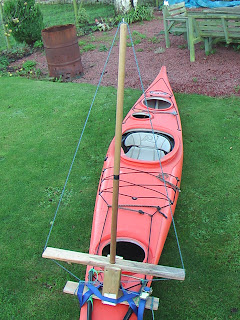After choosing which frame to use I dispensed with the wood as much as possible to cut down on weight. I placed plastic tubing underneath the frame to give it a level foundation. I then secured the frame to the plastic tubing by way of drilling holes in the frame and tubing and tying it with a plastic line. I tied the tubing to the safety rope which runs along the kayak hull. The tubing is only to give the frame a steady base when heeling. I then secured the frame to the hull by tying it down firmly with bunji. When secured I pulled and tugged at the frame in different directions to assimilate heeling, the kayak moved and the frame stayed secure.
Web Page and Blog of: Ethnomusicology, Music making, Instrument making, Bagpipes, Ney Flutes, Workshops, Activities...
Tuesday, October 18, 2011
Kayak Frame Completed
I am a firm believer in securing most things on a boat with rope instead of bolts and screws, rope gives a small amount of movement and is easily adjusted and replaced and is less wear on the hull.
After choosing which frame to use I dispensed with the wood as much as possible to cut down on weight. I placed plastic tubing underneath the frame to give it a level foundation. I then secured the frame to the plastic tubing by way of drilling holes in the frame and tubing and tying it with a plastic line. I tied the tubing to the safety rope which runs along the kayak hull. The tubing is only to give the frame a steady base when heeling. I then secured the frame to the hull by tying it down firmly with bunji. When secured I pulled and tugged at the frame in different directions to assimilate heeling, the kayak moved and the frame stayed secure.
Later, I secured the frame firmly to the hull with a better and more tighter strapping system. Also I inserted the mast and ran a line from the spreaders through the mast head and down to the other spreader this stopped the mast from falling out in a capsize. I pulled at the mast and the kayak moved but the frame stayed rigid. I felt satisfied the frame is ready for the sail.
After choosing which frame to use I dispensed with the wood as much as possible to cut down on weight. I placed plastic tubing underneath the frame to give it a level foundation. I then secured the frame to the plastic tubing by way of drilling holes in the frame and tubing and tying it with a plastic line. I tied the tubing to the safety rope which runs along the kayak hull. The tubing is only to give the frame a steady base when heeling. I then secured the frame to the hull by tying it down firmly with bunji. When secured I pulled and tugged at the frame in different directions to assimilate heeling, the kayak moved and the frame stayed secure.
Subscribe to:
Post Comments (Atom)



No comments:
Post a Comment